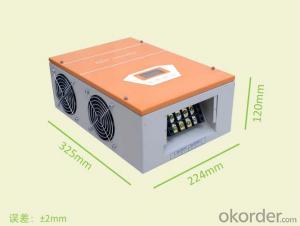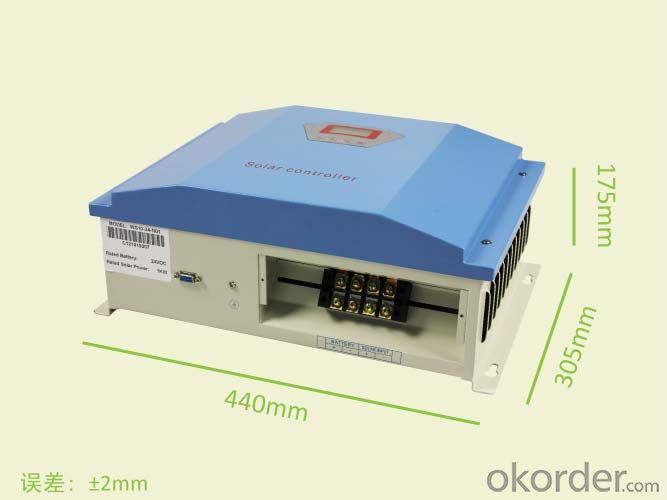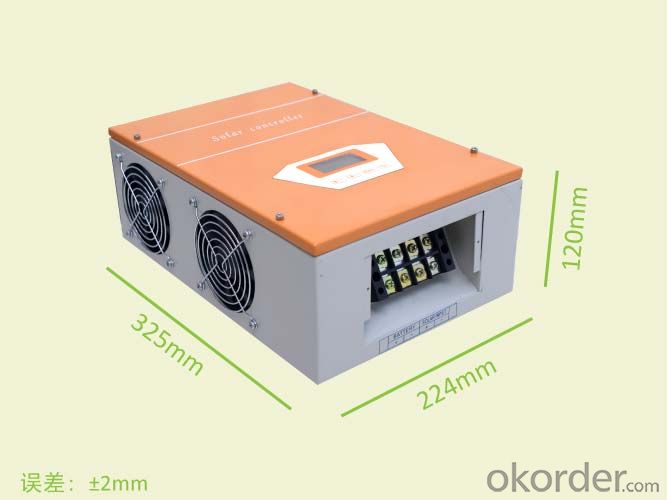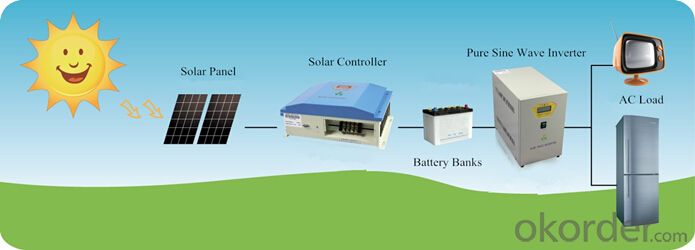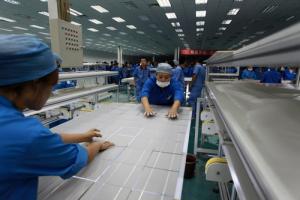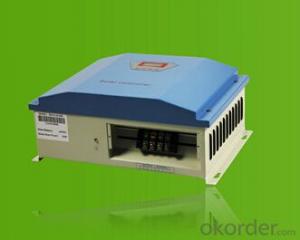Water Resistant Solar Charge Controller 2KW MPPT Charging Function
- Loading Port:
- Shanghai
- Payment Terms:
- TT or LC
- Min Order Qty:
- 1 unit
- Supply Capability:
- 10000 unit/month
OKorder Service Pledge
OKorder Financial Service
You Might Also Like
I. PRODUCT INTRODUCTION
Solar controller is control device which can control solar panel and transform solar energy into electricity then store to the battery bank. Solar controller is the most important part in off-grid system, whose performance has much effect on life expectancy and operation of the whole system, especially the battery expectancy. Or battery service life will be shortened by over charge or over discharge.
II. PERFORMANCE FEATURES
Superior military-grade components to ensure the product stability.
Perfect protection function, thus the system has higher reliability.
Check and set all operation parameters as requirement from LCD display.
PWM stepless unload mode, which burn the excess power into Dump load, making the battery charging in best status.
III. APPLICATION AREAS
Standalone Photovoltaic power station
Standalone Domestic household photovoltaic power system
Mobil communication base stations, expressway and other non-residential regions.
Coastal islands, remote mountainous, border posts for regions shortage of or without electricity.
Government demonstration projects, landscape lighting project etc.
IV. 2KW TECHNICAL PARAMETERS
Product model | WS20-48-N00 | WS20-96-N00 | WS20-110-N00 | WS20-120-N00 | WS20-220-N00 |
Rated battery power | 48V | 96V | 110V | 120V | 220V |
Rated solar input power | 2kW | 2kW | 2kW | 2kW | 2kW |
Floating charge voltage | 58V | 116V | 133V | 145V | 266V |
Max Open Circuit Voltage | 100V | 200V | 230V | 250V | 458V |
Dimensions (L x W x H) | 442×307×172 mm | ||||
Net weight | 7kg | ||||
Display mode | LCD | ||||
Cooling | Fan | ||||
Protection level | IP20(Indoor) | ||||
Quiescent current | ≤20 mA | ||||
Protection functions | Battery over charge; battery anti-reverse-connection; solar reverse charge protection; solar anti-reverse-connection; lightning protection. | ||||
Ambient temperature | -20~+55℃ | ||||
Ambient humidity | 0~93%, without condensing | ||||
Working altitude | ≤4000m | ||||
In order to serve our customers better, our company can adjust parameter configuration according to customer’s requirement. | |||||
- Q: What are the main components of a solar controller?
- The main components of a solar controller typically include a charge controller, which regulates the flow of electricity between the solar panel and the battery, ensuring the battery is not overcharged or damaged. Additionally, a solar controller may also have a load controller, which manages the flow of electricity from the battery to the connected load, such as lights or appliances. Some advanced solar controllers may also include features like LCD screens, voltage regulators, temperature sensors, and communication ports.
- Q: Can a solar controller be used with solar-powered refrigerators?
- Yes, a solar controller can be used with solar-powered refrigerators. A solar controller regulates the flow of electricity from solar panels to the refrigerator, ensuring that the energy is efficiently utilized and preventing overcharging or damage to the system. It helps optimize the performance and lifespan of the solar-powered refrigerator, making it an essential component for its operation.
- Q: Can a solar controller handle different battery types (lead-acid, lithium-ion, etc.)?
- Yes, a solar controller can handle different battery types including lead-acid, lithium-ion, and others. However, it is important to choose a solar controller that is compatible with the specific battery type being used to ensure optimal charging and performance.
- Q: How does a solar controller handle high current flow from the solar panels?
- A solar controller handles high current flow from the solar panels by regulating and distributing the current to the battery and load. It uses various electronic components such as MOSFETs, transistors, and resistors to maintain a stable charging voltage and prevent overcharging. The controller continuously monitors the current and voltage levels from the solar panels and adjusts its internal circuitry to efficiently handle the high current flow while protecting the battery and load from any potential damage.
- Q: What is the maximum input voltage for a solar controller with an LCD display?
- The maximum input voltage for a solar controller with an LCD display depends on the specific model and manufacturer. It is important to refer to the product's specifications or user manual to determine the exact maximum input voltage for that particular solar controller.
- Q: Can a solar controller be used with solar-powered indoor waste recycling systems?
- Yes, a solar controller can be used with solar-powered indoor waste recycling systems. A solar controller is a device that regulates and manages the flow of electricity from solar panels to batteries, ensuring optimal charging and preventing overcharging or damage to the batteries. In the case of indoor waste recycling systems powered by solar energy, a solar controller is necessary to ensure that the solar panels are efficiently charging the batteries that power the system. This allows for continuous operation of the waste recycling system even in low-light or cloudy conditions. Thus, a solar controller is an essential component in maintaining the functionality and efficiency of solar-powered indoor waste recycling systems.
- Q: What is the maximum operating altitude of a solar controller?
- The maximum operating altitude of a solar controller typically depends on the specific model and manufacturer. However, most solar controllers can operate effectively at altitudes up to 4,000 meters (13,123 feet) above sea level. It is important to refer to the product specifications or consult the manufacturer for accurate information regarding a particular solar controller's maximum operating altitude.
- Q: Can a solar controller be used in an industrial solar system?
- Yes, a solar controller can be used in an industrial solar system. A solar controller helps regulate and optimize the charging of the batteries in a solar system, ensuring maximum efficiency and lifespan of the batteries. It also helps protect the system from overcharging and over-discharging. Therefore, it is essential to have a solar controller in an industrial solar system to enhance its performance and overall functionality.
- Q: Can a solar controller be used with solar panels of different flexibilities?
- Yes, a solar controller can be used with solar panels of different flexibilities. The main purpose of a solar controller is to regulate the charging process of the batteries connected to the solar panel system. It manages the flow of electricity from the solar panels to the batteries, ensuring an optimal charge. The flexibility of the solar panels, whether rigid or flexible, does not affect the compatibility with the solar controller. As long as the solar panels are designed to generate electricity from sunlight, they can be connected to a solar controller to charge the batteries effectively.
- Q: Are there any efficiency differences between PWM and MPPT solar controllers?
- PWM and MPPT solar controllers have efficiency differences. Compared to MPPT controllers, PWM controllers have a simpler design and are generally less expensive. However, they are less efficient at converting the solar panel's output to the battery's charging voltage. PWM controllers achieve voltage regulation by rapidly turning the solar panel's output on and off, resulting in a square wave output. This can lead to some energy loss because the solar panel's output voltage is not always perfectly matched to the battery's charging voltage. On the other hand, MPPT controllers utilize advanced algorithms to constantly adjust the solar panel's output voltage and current. This allows them to find the maximum power point, where the panel operates at its highest efficiency. By dynamically adjusting the charging voltage and current, MPPT controllers can extract more power from the solar panel and deliver it to the battery, resulting in overall higher system efficiency. MPPT controllers are especially advantageous when the solar panel's voltage is significantly higher than the battery's charging voltage. In such cases, using PWM controllers would result in substantial energy loss, while MPPT controllers can efficiently convert the higher voltage to the battery's required voltage. In summary, while PWM controllers are simpler and more affordable, MPPT controllers offer greater efficiency in converting solar energy to battery charging voltage. The choice between the two depends on factors such as cost, system design, and the specific requirements of the solar power system.
Send your message to us
Water Resistant Solar Charge Controller 2KW MPPT Charging Function
- Loading Port:
- Shanghai
- Payment Terms:
- TT or LC
- Min Order Qty:
- 1 unit
- Supply Capability:
- 10000 unit/month
OKorder Service Pledge
OKorder Financial Service
Similar products
Hot products
Hot Searches
Related keywords

